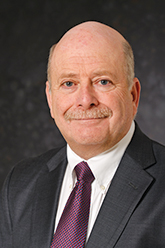News
2015 Technical Excellence Award Recipients
Dr. Daniel A. O'Connor
 For his outstanding technical
contributions to the field of ballistic
missile defense (BMD), creativity
in developing
and demonstrating
techniques for BMD, and leadership
in initiating a major national effort
in discrimination technology
For his outstanding technical
contributions to the field of ballistic
missile defense (BMD), creativity
in developing
and demonstrating
techniques for BMD, and leadership
in initiating a major national effort
in discrimination technology
Dr. Daniel A. O'Connor is Leader of the Ballistic Missile Defense System Integration Group at MIT Lincoln Laboratory. Prior to his leadership of this group, he served as the Leader of the Systems and Architectures Group (2004–2008) and the Advanced Concepts and Technology Group (2008–2010). He is currently leading the Laboratory's development efforts in integration of ballistic missile defense sensors, weapons, and battle management centers.
Since joining the Laboratory in 1982, Dr. O'Connor has conducted research on tracking, discrimination, and defense system architectures. His initial work involved systems analysis for strategic missile defense. He served a two-year tour at the Reagan Test Site on the Kwajalein Atoll, Marshall Islands, as a system engineer for the Target Resolution and Discrimination Experiment (TRADEX) radar. After his return to the main Lincoln Laboratory site in Lexington, Massachusetts, he worked on the Theater Missile Defense Critical Measurements Program, focusing on the analysis of radar and electro-optic observables and the development of discrimination techniques. Dr. O'Connor also supported the Aegis Advanced Technology Program, developing radar algorithms for regional missile defense. From 2000 to 2009, he led Lincoln Laboratory's efforts that supported Project Hercules, a Missile Defense Agency program to develop and test advanced sensor decision-making algorithms.
Dr. O'Connor graduated from Clarkson University with a bachelor's degree in electrical engineering and earned master's and doctoral degrees in system science and mathematics from Washington University in St. Louis, Missouri. From 1978 to 1982, he was an assistant professor of electrical engineering at Clarkson.
Joseph J. Scozzafava
 For his leadership and creativity in developing laser communications technology, significant contributions to solving critical mechanical issues on major space payload and radar developments, and innovative work on mechanical rotary interface and electro-optical devices.
For his leadership and creativity in developing laser communications technology, significant contributions to solving critical mechanical issues on major space payload and radar developments, and innovative work on mechanical rotary interface and electro-optical devices.
Joseph J. Scozzafava is the Leader of the Mechanical Engineering Group at Lincoln Laboratory. He has worked on a wide variety of technologies—large ground-based and sea-based radars, unique airborne sensors and communication systems, and optical space payloads, including free-space optical communication systems.
Mr. Scozzafava started his work in optical communications at the Laboratory by planning the integration and test efforts for the Geosynchronous Lightweight Integrated Technology Experiment, a demonstration of the world's first successful space-based high-rate optical communication system. His subsequent work in this area has been instrumental in several large NASA development programs, including the Mars Laser Communication Demonstration and the subsequent Lunar Laser Communication Demonstration (LLCD). The LLCD program used optical communications to transmit data from a lunar orbiting terminal to a terminal on Earth's surface at a record-breaking download speed of 622 megabits per second. Mr. Scozzafava developed the initial mechanical design concept for a compact, low-mass, low-power inertially stabilized optical terminal that was foundational to the LLCD system. In 2014, R&D Magazine selected the LLCD as a recipient of a R&D 100 Award.
After joining the Laboratory in 1983 as a member of the Mechanical Engineering Group, Mr. Scozzafava joined the Optical Systems Engineering Group that formed in 1986. There he developed the mechanical systems associated with electro-optic devices and invented a unique mechanical rotary interface for use in advanced sensor systems. He returned to the Mechanical Engineering Group in 1998 as an Assistant Leader, and was promoted to Associate Leader in 2003 and Leader in 2008. He has served as the associate program manager for multiple programs, including the Laboratory's largest optical communications program. He contributed significantly to resolving critical mechanical problems encountered in several major hardware projects. His current efforts are focused on advancing his group's engineering and fabrication capabilities. Mr. Scozzafava holds a bachelor's degree in mechanical engineering from the University of Bridgeport.